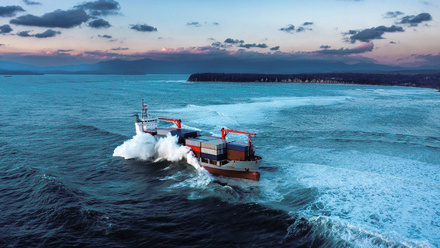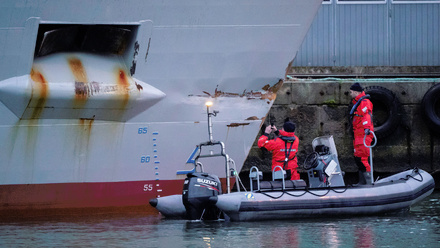Code of practice called for following fatality on ro-ro vessel
A fatal accident to a bosun on board the Clipper Pennant at Gladstone Dock, Liverpool results in a plea for ‘decisive action’.
The fatal crushing of 67-year-old Polish seafarer, Kazimierz Ptak, by a tractor unit on Seatruck’s Clipper Pennant, is one that reflects the dangers of people and vehicles operating within the same area.
In the subsequent report, the Marine Accident Investigation Branch (MAIB) highlighted “routine divergence from safe working practices on vehicle decks due, in part, to procedures and guidelines that do not align with or reflect actual work practices” prompting them to announce: “Decisive action is needed to protect workers on ferry vehicle decks”.
After pointing to a similar incident in 2024 on board the ferry Laureline, Chief Inspector of Marine Accidents, Andrew Moll OBE, stated: “I have recommended that industry organisations develop a unified code of practice for vehicle deck safety on roll-on/roll-off [ro-ro] vessels and that regulators review and amend their codes and guidelines to align with industry derived best practices.”
On a ro-ro carrier, trailers full of cargo are driven onto a vessel using a tractor unit, ready to be driven off at the other end of the voyage. This is considered more time-efficient than a container ship. In an unaccompanied ro-ro, trailers are dropped by the quayside and driven onto the vessel by a specialised swivelling tractor unit.
MS UR was built in 2009. At the time the incident concerned, the vessel was named Clipper Pennant and was operated by Seatruck Ferries. At the vessel’s fore, where several bays for trailers were situated, there was a design flaw: not quite enough space for five trailers. In one of the stowage bays, space 21, a designated emergency exit door leading to the vessel’s break room, would be occluded by a trailer.
As a workaround, the crew had painted a thick yellow line along the deck next to the port bulkhead, hoping that it would prompt the drivers to squeeze their trailers into a slightly narrower space, giving crew room to move around. The space was just wide enough to accommodate a trailer, but as the crew would learn, not enough to give its driver room to manoeuvre.
A banksman has a hazardous job on a ro-ro carrier, co-ordinating the reversing-in of each trailer. This requires them to stand to the rear of the reversing truck, though at no point – made clear by the procedures - directly behind it. The ship’s bosun, Ptak, was acting as banksman on July 20, 2021.
What happened on the day
A 66-year-old tractor driver, who had been working at the Port of Liverpool for 14 years, was backing a trailer into Clipper Pennant’s cargo space 21, with the help of the bosun, acting as banksman. The bosun stood on the yellow-painted walkway the crew had created and waved at the driver to begin his manoeuvre.
The driver, who had swivelled around into the rearward-facing position, had swerved slightly to the left; his trailer had correspondingly swung to the right, leaving his vision obstructed to the extent that he was forced to lean out of the window to maintain visibility. Correcting his angle, he swung right, the trailer correspondingly swinging left, and continued his manoeuvre.
Though he could no longer see the bosun, he heard one sharp blast on the banksman’s whistle to indicate it was time to stop. As he decoupled his tractor and drove off to collect the next load, what he did not know was that the wheels of his trailer had swerved onto the yellow painted surface of the makeshift walkway – and that the trailer had pinned the bosun in a corner between the bulkhead and a protruding stiffening beam.
The bosun was found by another crew member, several minutes after the manoeuvre had completed, unconscious and with mortal crush injuries. He was declared dead by attending paramedics some 30 minutes later.
Findings and outcome
The crew’s makeshift walkway, MAIB deemed, gave them a false sense of security. With no material barrier between the trailer and the bosun, and a marginally narrower space than the others, the yellow paint had done nothing to stop the impact.
It was a matter of routine for the driver and banksman to break visibility with one another, a violation of procedure which, after all, had been committed many times before without killing anybody. “This undocumented procedural workaround had become routine practice in Liverpool and was repeated multiple times a day without consequences,” MAIB’s incident report determined, and: “The driver continued without stopping under the assumption that the bosun would keep out of the way and not move himself into a dangerous position.”
The bosun’s crewmates had likewise traded safety for efficiency. Instead of accompanying the procedure, they were busy lashing nearby trailers, allowing them to be faster and more productive at loading the vessel. “Over time the deck ratings had developed working practices that were more efficient… and it became normal not to see the bosun as he marshalled a semi-trailer,” MAIB reported.
MAIB identified that doing everything to the letter would not have saved the bosun, either. It called the Seatruck and P&O procedures “...a limited number of idealistic static scenarios,” which “...did not represent the dynamic nature of the vehicle deck operation, where the line of sight between the banksman and driver was often neither practical nor possible.”
“Seatruck and P&O were aware of the procedural workaround used by the crew but did not intervene to stop the unsafe practice, for which neither a risk assessment nor SSW [safe system of work] had been completed, despite it conflicting with each company’s SMS [safety management system]. This was probably because a formal assessment of this workaround would have identified certain spaces that could not be loaded according to the procedures, which would have meant either removing the space from service or developing space-specific procedures.”
Since the accident, Seatruck Ferries acted to improve safety on its vehicle decks, including: “Developing a new safe system of work that recognises dynamic danger zones and establishing standard loading procedures that better reflect the work performed.”
The Human Element Working Group (HEWG) strives to improve safety and operational efficiency. Join now.
Image: Clipper Pennant in the port of Dublin; credit: Shutterstock.
Tell us what you think about this article by joining the discussion on IMarEST Connect.






